
 |
|
|
|
#1
|
||||
|
||||
|
An experienced kiter was launching a new 9 m flat kite for the first time in strong, very gusty side onshore winds. The rider had many years experience with C kites but reportedly had less than two sessions with flat kites. A group of riders had visited this launch from out town and had setup up outside of the approved area. The wind record shown below suggests winds 22 gusting to 30 kts. around the time of the accident at 2:30 pm and substantially higher prior. Squalls were reportedly not present with winds resulting from a powerful cold front.
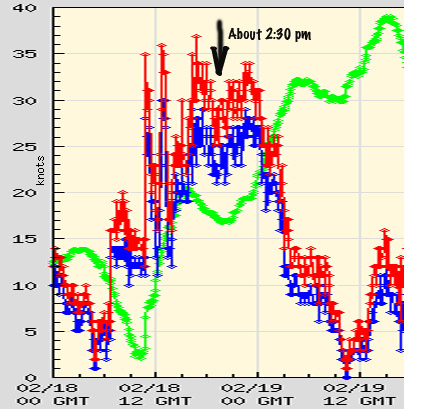 Other experienced kiters were out on 7 m and 9 m flat kites and heavily powered. A bridal line was wrapped around a wingtip without the knowledge of the kiter or his assistant apparently when the kite was picked up to launch. 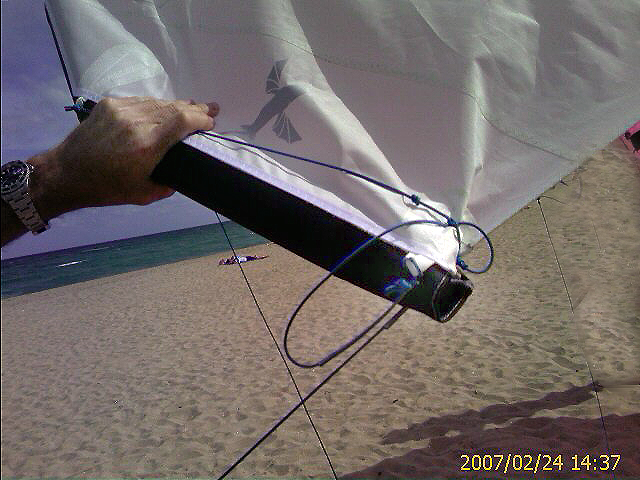 How the bridle may have been wrapped over the wingtip. After the kite was released it began to immediately spin out of control, fully powered up looping in the power zone dragging the kiter. The rider had attached his leash above the chicken loop and dropped his bar to fully depower the kite. The depowering mechanism relies upon the leading edge bridle which was snagged in place by the tangle eliminating the depower function. So despite dropping his bar the kite did not significantly depower as he was dragged along. 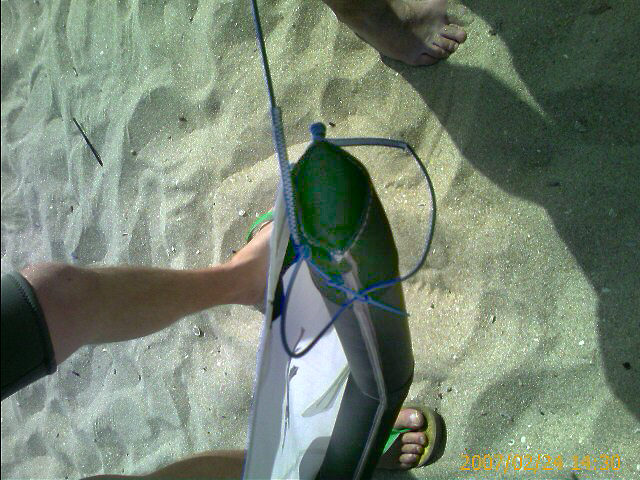 Another view of how the bridle may have been tangled. The kiter that had launched him ran forward and jumped on him to hold him in place. Both were subsequently dragged until the helper was knocked off breaking a finger. Another well experienced kiter ran up when the kite hit the ground and grabbed one line to try to depower the kite. The kite relaunched causing a serious cut to the man's little finger and hand. 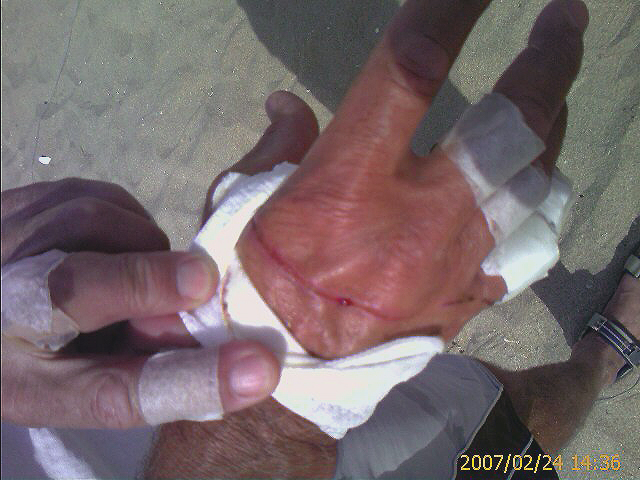 Hand injuries The rider hit several objects during the dragging including two other kiters standing on the beach and breaking a 4" x 4" timber embedded in the dune with his shoulder. 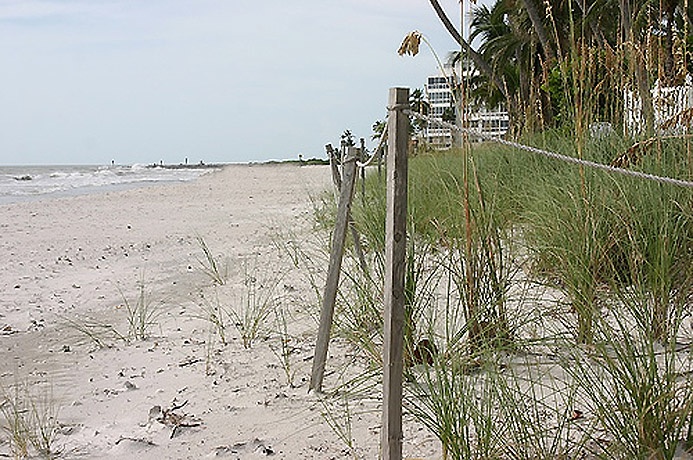 A similar section of beach with stakes used to rope off the sea oats as well. Smaller timbers are shown in use here than at the scene of the accident. The kite struck a palm tree, ending the dragging after the rider had traveled about 150 ft. up the beach. His leash broke shortly before this time. Aside from cuts and bruises the rider and other participants were reportedly OK. The one man that grabbed the kite line received stitches for his hand laceration.
__________________
FKA, Inc. transcribed by: Rick Iossi Last edited by ricki; 02-25-2007 at 09:22 PM. |
|
#2
|
||||
|
||||
|
Several things come to mind from this accident:
1. Never use new or unfamiliar gear in extreme conditions no matter how experienced you are. 2. Rider and helper must verify that lines and bridles are correct before releasing the kite. The kiter may not be able to see something like this during launch. 3. Avoid using kites near the upper end of the recommended wind range (32 kts. in this case) and never when new to the gear. 4. NOTE: Carefully evaluate where to attach your kite leash on flat kites, particularly when near shore. Reportedly, if attached to the Oh Shit Handle this kite will substantially depower, as long as the flight line doesn't break. If attached to the chicken loop as was done in this case, the depower may be disabled by breakage or snags. There are still other options with other kites, speak with manufacturer's reps if necessary. Spend some time on this and choose well. 5. Never grab a line attached to a powered up kite. 6. Rehearse mentally and physically dealing with a overpowered emergency by totally depowering the kite and finding and releasing the leash attachment to the kiter (should the later prove to be necessary in an emergency). 9. Always wear a good helmet, impact vest, hook knife, gloves and other gear as appropriate. 10. Always research where to ride before going to a beach. Preservation of access concerns us all.
__________________
FKA, Inc. transcribed by: Rick Iossi Last edited by ricki; 02-28-2007 at 08:00 AM. |
|
#3
|
||||
|
||||
|
This rider was incredibly lucky to have suffered fairly minor injury in a flat kite accident which could have EASILY been fatal. Other kiters on the beach might have also been seriously injured as well. He couldn't see the kite being launched and the helper may not have been all that familiar with flat kites. Some things to think about related to assisted launching and past accidents appear HERE
Both are very experienced with C kites. Hanging on to a kite for launch in high wind and blasting sand isn't all that easy a proposition particularly when the kite is near its upper wind limit. The time to experiment with new gear is not in such extreme conditions. Also, avoid "soft" leash attachment clips, for a good reason why click HERE Another kiter had advised the rider not to attach his leash to the chicken loop but instead attach it to his Oh Shit handle and shift it over once well offshore. The rider was not that comfortable with this as he was used to suicide leash attachments on C kites through the chicken loop. NOTE: There are significant DIFFERENCES between flat kites and C kites, learn what they are by carefully reading the user manual, talking to other kiters and carefully building experience with the flat kite under controlled circumstances. Just because you are used to attaching your leash to the chickenloop or even the bypass leash attachment, doesn't necessarily mean this is a good place to attach to while near shore. In the current case, attaching to the Oh Shit handle until well offshore and then moving it to the chicken loop would have made more sense. What happens if a bridle breaks? Maybe something not all that different. Make sure you know where your leash attachment quick release is and be familiar with activating it. On top of your butt may not be the best location for this either. Too many kiters ignore this simple step in self preservation along with even practicing totally depowering their kite. "I'll figure it out in the emergency," unlikely. A stopper ball can simulate some of what happened in this accident. Don't engage stopper balls on flat kites nearshore or when you might potentially crash (i.e. before jumping). Experienced guys don't need helmets or impact vests because ... ? Luck is great while it lasts but some basic safety gear may stretch your luck when you unexpectedly get dragged south at lightspeed someday. Overconfidence can be a killer not only in kiting but in many action sports. Flat kites may reduce kiting fatalities but the capacity to injure and kill is still there. Be careful out there.
__________________
FKA, Inc. transcribed by: Rick Iossi Last edited by ricki; 02-25-2007 at 09:19 PM. |
|
#4
|
|||
|
|||
|
Rick,
Thanks for the info. I hope the kiters' injuries heal soon. Props to the other kiters who tried to help out. Sounds like they laid a lot on the line in their efforts. To me launching a kite is one of the most vulnerable moments we encounter in kiting. Having bridles on the kites obviously increases the odds of something going wrong on the launch, like with this unfortunate incident. As a preventative measure, I always keep one finger in the QR loop during launch so that if anything goes even slightly wrong, I am "outta there" instantly. If I even flinch while launching, I will probably activate my QR. It's kind of a built in "kite ejector" unless everything goes smoothly on the launch. It's just not possible to grab a QR while getting dragged and bounced around. I bet this kiter tried, or maybe stuff just happened too fast. Either way, it's not easy, I learned the hard way. I hope he heals up real fast. |
|
#5
|
||||
|
||||
|
this is a common issue with bridled kites..
local rider and hello kitty inventor E-bone was the first in area to pick up a Waroo.. on one of his first solo launches he got a bridle wrap that resulted in a looping spiral of DOOM not unlike the this other guy. Luckily for E-bone, he was on a mostly deserted beach with ample room for error so his experience left him mostly with only a bruised ego and a broken leash attachment on his harness. Had he been in crowded conditions it would have been a different story. I know that others here would have jumped in to help and might have ended up getting themselves hurt... Eric's story is in the back of my mind on every lauch of my Waroos.. I always tell the person launching me to make sure the bridles are clear and I make sure to get a visual of them myself before I give a thumbs up. |
|
#6
|
||||
|
||||
|
Do you see folks that routinely engage the stopper balls most of the time? That is launching, landing, riding?
Scott, you have a hand on your leash attachment QR when launching, correct? Bryan, good points. Usually, most of the responsibility should rest with the guy being launched or the pilot. It seems though that it is possible to have a bridle tangle that develops when the kite is picked up for launch and the pilot is 75 ft. away and perhaps unable to clearly see this. So, new burdens may fall on the helper that previously didn't exist. It would be good to talk this over with your helper prior to launch. Particularly hand signals as well, thumbs up, fist to hold and to never just drop or toss the kite among quite a few other precautions. Just like with C kites, the kite should feel like it wants to fly if it is ready to let it go.
__________________
FKA, Inc. transcribed by: Rick Iossi |
|
#7
|
||||
|
||||
|
Let me see if I can summarize a general approach at this point for flat kites:
1. Carefully preflight, including making sure pulleys move easily and lines aren't worn, your leading edge, batten pressures are adequate, check proper attachment, run down the lines looking for twists, tangles, knots, wear/cuts, etc.. ** 2. Make sure your helper/launcher knows what to do, signals for doing it and what to look for. 3. The pilot attaches his leash to the appropriate spot for his kite system for nearshore conditions. (read the manufacturers directions, try it out in lighter conditions, think carefully about how you are going to do this) 4. Both guys get in position, the helper picks the kite up and holds it. (I use one arm curved over my head in a "C shape" to signal this). Kite closest to the water is advisable in most but perhaps not all launch areas. 5. The pilot checks system, down the lines, makes sure the leading edge lines form a nice Vee, the trailing edge lines stay on the outside, bridles seem to be right and the kite has a proper shape. 6. The helper/launcher checks system, looks at all the bridles, makes sure the leading edge lines converge in a vee at the pilot, back lines stay outside, kite is shaped properly and feels like it "wants" to take off. If not, why not? 7. Pilot gives thumbs up, helper replies with thumbs up if appropriate other wise shakes head no or holds up a fist. The pilot can use these same signals, don't rely upon verbal communication. If the helper doesn't like the feel of things he can pop the kite over on the leading edge to deal with it. Nothing says he has to launch. 8. Helper starts to let kite go making sure it wants to fly and is ready to grab it if not. He DOESN'T throw it, drop it or watch it roll down the beach. He stays ready to help, waits to see that the kite is flying and pilot is moving on. 9. Pilot is ready/practiced to abort, sheet out totally, DON"T hold bar in too long. Spinning lines can disable depowering at times. Be ready and practiced to release your leash attachment to your body if necessary. Go over this stuff in advance to try to avoid FREEZING. 10. If your kite goes down, worse rolls, expect possible tangles and disabling of depowering. Be ready to react early. This is detailed, then again many (most) accidents are caused lack of attention to detail. Use your head and have fun or risk using your melon for a doorstop and spend time in the ER and/or kite repair. Most of this should be second nature to most kiters and experienced helpers. This isn't exhaustive, nor specific to all kite systems. What have I left out that should be in a general checklist? ** More about flat or hybrid kite Preventive Maintenance (working to make stuff work better, longer) in the next SBC Kiteboard Magazine by the way.
__________________
FKA, Inc. transcribed by: Rick Iossi Last edited by ricki; 03-02-2007 at 08:15 AM. |
 |
|
|